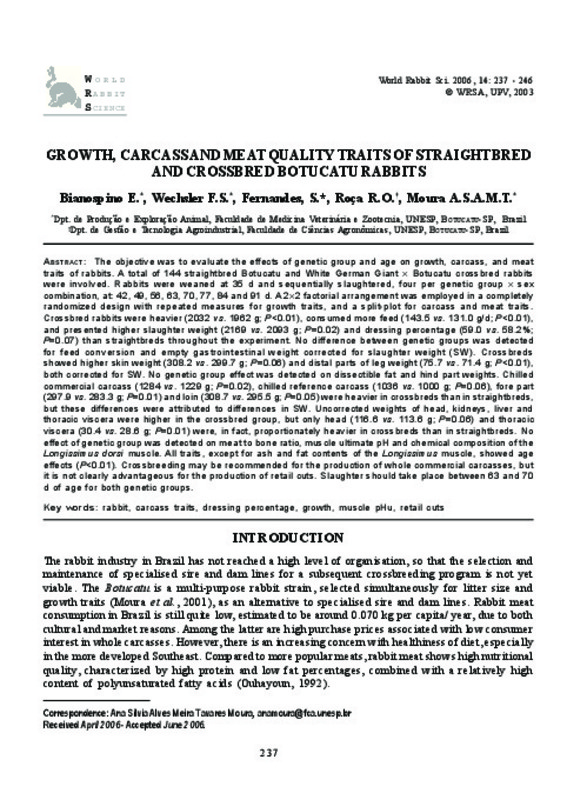JavaScript is disabled for your browser. Some features of this site may not work without it.
Buscar en RiuNet
Listar
Mi cuenta
Estadísticas
Ayuda RiuNet
Admin. UPV
Growth, carcass and meat quality traits of straightbred and crossbred botucatu rabbits
Mostrar el registro sencillo del ítem
Ficheros en el ítem
| dc.contributor.author | Bianospino, E.
|
|
| dc.contributor.author | Wechsler, F.S.
|
|
| dc.contributor.author | Fernandes, S.
|
|
| dc.contributor.author | Roça, R.O.
|
|
| dc.contributor.author | Moura, A.S.A.M.T.
|
|
| dc.date.accessioned | 2011-02-09T10:15:51Z | |
| dc.date.available | 2011-02-09T10:15:51Z | |
| dc.date.issued | 2006 | |
| dc.identifier.issn | 1257-5011 | |
| dc.identifier.uri | http://hdl.handle.net/10251/9566 | |
| dc.description.abstract | [EN] The objective was to evaluate the effects of genetic group and age on growth, carcass, and meattraits of rabbits. A total of 144 straightbred Botucatu and White German Giant x Botucatu crossbred rabbitswere involved. Rabbits were weaned at 35 d and sequentially slaughtered, four per genetic group x sexcombination, at: 42, 49, 56, 63, 70, 77, 84 and 91 d. A 2-2 factorial arrangement was employed in a completelyrandomized design with repeated measures for growth traits, and a split-plot for carcass and meat traits.Crossbred rabbits were heavier (2032 vs. 1962 g; P<0.01), consumed more feed (143.5 vs. 131.0 g/d; P<0.01),and presented higher slaughter weight (2169 vs. 2093 g; P=0.02) and dressing percentage (59.0 vs. 58.2%;P=0.07) than straightbreds throughout the experiment. No difference between genetic groups was detectedfor feed conversion and empty gastrointestinal weight corrected for slaughter weight (SW). Crossbredsshowed higher skin weight (308.2 vs. 299.7 g; P=0.06) and distal parts of leg weight (75.7 vs. 71.4 g; P<0.01),both corrected for SW. No genetic group effect was detected on dissectible fat and hind part weights. Chilledcommercial carcass (1284 vs. 1229 g; P=0.02), chilled reference carcass (1036 vs. 1000 g; P=0.06), fore part(297.9 vs. 283.3 g; P=0.01) and loin (308.7 vs. 295.5 g; P=0.05) were heavier in crossbreds than in straightbreds,but these differences were attributed to differences in SW. Uncorrected weights of head, kidneys, liver andthoracic viscera were higher in the crossbred group, but only head (116.6 vs. 113.6 g; P=0.06) and thoracicviscera (30.4 vs. 28.6 g; P=0.01) were, in fact, proportionately heavier in crossbreds than in straightbreds. Noeffect of genetic group was detected on meat to bone ratio, muscle ultimate pH and chemical composition of theLongissimus dorsi muscle. All traits, except for ash and fat contents of the Longissimus muscle, showed ageeffects (P<0.01). Crossbreeding may be recommended for the production of whole commercial carcasses, butit is not clearly advantageous for the production of retail cuts. Slaughter should take place between 63 and 70d of age for both genetic groups. | es_ES |
| dc.description.sponsorship | This research received financial support from the “Fundação de Amparo à Pesquisa do Estado de São Paulo” (FAPESP), Brazil. Elaine Bianospino received a scholarship from CAPES, Brazil. The authors thank Mrs. I. F. Arruda, M. C. Francisco and C. B. do Nascimento for technical assistance. | |
| dc.language | Inglés | es_ES |
| dc.publisher | World Rabbit Science. ICTA. UPV | es_ES |
| dc.relation.ispartof | World Rabbit Science | |
| dc.rights | Reserva de todos los derechos | es_ES |
| dc.subject | Rabbit | es_ES |
| dc.subject | Carcass traits | es_ES |
| dc.subject | Dressing percentage | es_ES |
| dc.subject | Growth | es_ES |
| dc.subject | Muscle phu | es_ES |
| dc.subject | Retail cut | es_ES |
| dc.title | Growth, carcass and meat quality traits of straightbred and crossbred botucatu rabbits | es_ES |
| dc.type | Artículo | es_ES |
| dc.date.updated | 2011-02-09T08:35:20Z | |
| dc.identifier.doi | 10.4995/wrs.2006.563 | es_ES |
| dc.rights.accessRights | Abierto | es_ES |
| dc.description.bibliographicCitation | Bianospino, E.; Wechsler, F.; Fernandes, S.; Roça, R.; Moura, A. (2006). Growth, carcass and meat quality traits of straightbred and crossbred botucatu rabbits. World Rabbit Science. 14(4). https://doi.org/10.4995/wrs.2006.563 | es_ES |
| dc.description.accrualMethod | SWORD | es_ES |
| dc.relation.publisherversion | https://doi.org/10.4995/wrs.2006.563 | es_ES |
| dc.description.volume | 14 | |
| dc.description.issue | 4 | |
| dc.identifier.eissn | 1989-8886 | es_ES |
| dc.contributor.funder | Fundação de Amparo à Pesquisa do Estado de São Paulo |








